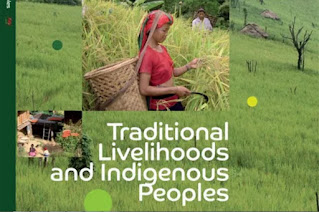INTRODUCTION
The traditional
livelihoods in India have been diverse and vibrant.
·
The village as a
unit used to be self sufficient in producing all the necessary goods and
services required by people.
·
Different social
groups used to specialize in different types of occupations.
TRADITIONAL LIVELIHOOD
IN AGRICULTURE
·
About 60% of the
population is employed in the agricultural sector, and roughly60% of the total
land is farmed.
·
India’s major
crops include rice, wheat, oilseed, cotton, jute, tea, sugarcane, onions, and
potatoes.
·
Nonfood crops
are mainly linseed, cotton, jute and tobacco.
·
India has been famous for its spices and today
is one of the world’s largest producers, consumers and exporters of a wide
range of spices.
TRADITIONAL LIVELIHOOD
IN INDUSTRY
·
Large modern
steel mills and many fertilizer plants, heavy machinery plants have added to
industry.
·
India has
established its role in the high-value added sector.
·
Nine states
(Maharashtra, West Bengal, Tamil Nadu, Gujarat, Uttar Pradesh, Bihar, Andhra
Pradesh, Karnataka and Madhya Pradesh) together account for most of Indian
Industry.
TRADITIONAL LIVELIHOOD
IN HANDICRAFT
·
Zari is an even
thread traditionally made of fine gold and silver used in traditional India.
·
Leather footwear: The major production centers n India are Chennai
and Ranipet in Tamil Nadu, Mumbai in Maharashtra.
·
Carpet: Various types of carpets
produced are hand knotted woolen carpets, pure silk carpet.
·
Cane and Bamboo: cane is used for
furniture making and bamboo is used for decorative items like lamp-stand,
umbrella handles, flower pots etc.
·
Wall painting: Floor and wall painting by Gond tribes of Madhya
Pradesh, is famous painting that has been followed as means of living hood.
TRADITIONAL LIVELIHOOD
IN SERVICES AND TOURISM
·
The Miudiyettu,
a ritual dance drama performed every year after summer in Kerala since 250
years.
·
The Chhau,
atribal ritual dance in Orissa, Jharkhand and west Bengal.
·
The folk songs
and dances of the Kabelia community of Rajasthan.
LIVELIHOOD IN RURAL
TOURISM
·
Agricultural
tourism meant to how farmers work with crops.
·
Cultural Tourism
meant how activities like rituals and festivals.
·
Nature tourism meant to conserve natural
environment.
·
Adventure
tourism meant limits to climbing hills.
·
Ethno tourism
meant to expand the horizon to know more about different ethnic and cultural
lifestyles.


Post a Comment
If you have any doubts, please let me know.